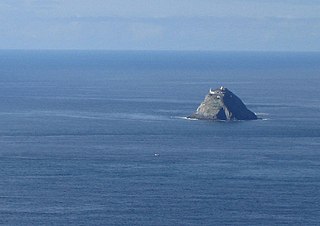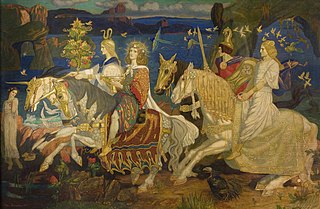
In Irish mythology, Donn is an ancestor of the Gaels and is believed to have been a god of the dead. Donn is said to dwell in Tech Duinn, where the souls of the dead gather. He may have originally been an aspect of the Dagda. Folklore about Donn survived into the modern era in parts of Ireland, in which he is said to be a phantom horseman riding a white horse.

Irish mythology is the body of myths indigenous to the island of Ireland. It was originally passed down orally in the prehistoric era. In the early medieval era, some myths were transcribed by Christian monks, who heavily altered and Christianised the myths. Irish mythology is the best-preserved branch of Celtic mythology.

The TuathaDé Danann, also known by the earlier name Tuath Dé, are a supernatural race in Irish mythology. Many of them are thought to represent deities of pre-Christian Gaelic Ireland.

Elysium, otherwise known as the Elysian Fields or Elysian Plains, is a conception of the afterlife that developed over time and was maintained by some Greek religious and philosophical sects and cults. It was initially separated from the Greek underworld – the realm of Hades. Only mortals related to the gods and other heroes could be admitted past the river Styx. Later, the conception of who could enter was expanded to include those chosen by the gods, the righteous, and the heroic. They would remain at the Elysian Fields after death, to live a blessed and happy afterlife, and indulge in whatever they had enjoyed in life.

Manannán or Manann, also known as Manannán mac Lir, is a sea god warrior and king of the Otherworld in Irish and Manx mythology who is one of the Tuatha Dé Danann.
Annwn, Annwfn, or Annwfyn is the Otherworld in Welsh mythology. Ruled by Arawn, it was essentially a world of delights and eternal youth where disease was absent and food was ever-abundant.
Lí Ban may refer to an otherworldly female figure in Irish mythology.

Aaru, or the Field of Reeds, is the name for heavenly paradise in Egyptian mythology. Ruled over by Osiris, an Egyptian god, the location has been described as the ka of the Nile Delta.

The Fortunate Isles or Isles of the Blessed were semi-legendary islands in the Atlantic Ocean, variously treated as a simple geographical location and as a winterless earthly paradise inhabited by the heroes of Greek mythology. In the time of Hesiod, the Fortunate Isles were associated with the concept of Elysium, a utopian location in the Greek underworld thought to be found in the Western ocean on the margin of the known world. The number of the islands would later be reduced to one by the poet Pindar.
The Voyage of Bran is a medieval seventh- or eighth-century Irish language narrative.

In Celtic mythology, the Otherworld is the realm of the deities and possibly also the dead. In Gaelic and Brittonic myth it is usually a supernatural realm of everlasting youth, beauty, health, abundance and joy. It is described either as a parallel world that exists alongside our own, or as a heavenly land beyond the sea or under the earth. The Otherworld is usually elusive, but various mythical heroes visit it either through chance or after being invited by one of its residents. They often reach it by entering ancient burial mounds or caves, or by going under water or across the western sea. Sometimes, they suddenly find themselves in the Otherworld with the appearance of a magic mist, supernatural beings or unusual animals. An otherworldly woman may invite the hero into the Otherworld by offering an apple or a silver apple branch, or a ball of thread to follow as it unwinds.
In Irish mythology, Tír na nÓg or Tír na hÓige is one of the names for the Celtic Otherworld, or perhaps for a part of it. Tír na nÓg is best known from the tale of Oisín and Niamh.

An immram is a class of Old Irish tales concerning a hero's sea journey to the Otherworld. Written in the Christian era and essentially Christian in aspect, they preserve elements of Irish mythology.
An Echtra or Echtrae, is a type of pre-Christian Old Irish literature about a hero's adventures in the Otherworld or with otherworldly beings.

Avalon, also known as Otherworld, is a fictional dimension appearing in American comic books published by Marvel Comics. It is based on the mythical Avalon from Celtic and, more specifically, Irish and Welsh mythology.
The Dindsenchas of Irish mythology give the physical origins, and etymological source of several bodies of water – in these myth poems the sources of rivers and lakes is sometimes given as being from magical wells.
In historical Indo-European religion, the concept of an otherworld, also known as an otherside, is reconstructed in comparative mythology. Its name is a calque of orbis alius, a term used by Lucan in his description of the Celtic Otherworld.

Celtic mythology is the body of myths belonging to the Celtic peoples. Like other Iron Age Europeans, Celtic peoples followed a polytheistic religion, having many gods and goddesses. The mythologies of continental Celtic peoples, such as the Gauls and Celtiberians, did not survive their conquest by the Roman Empire, the loss of their Celtic languages and their subsequent conversion to Christianity. Only remnants are found in Greco-Roman sources and archaeology. Most surviving Celtic mythology belongs to the Insular Celtic peoples. They preserved some of their myths in oral lore, which were eventually written down by Christian scribes in the Middle Ages. Irish mythology has the largest written body of myths, followed by Welsh mythology.

The Silver Branch or Silver Bough is a symbol found in Irish mythology and literature.

The Land of Maidens is a motif in Irish mythology and medieval literature, especially in the chivalric romance genre. The latter often also features a castle instead of an island, sometimes known as the Castle of Maidens.











